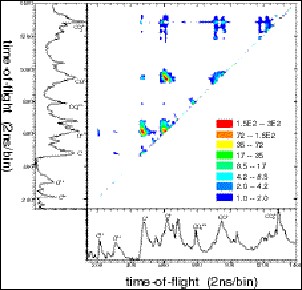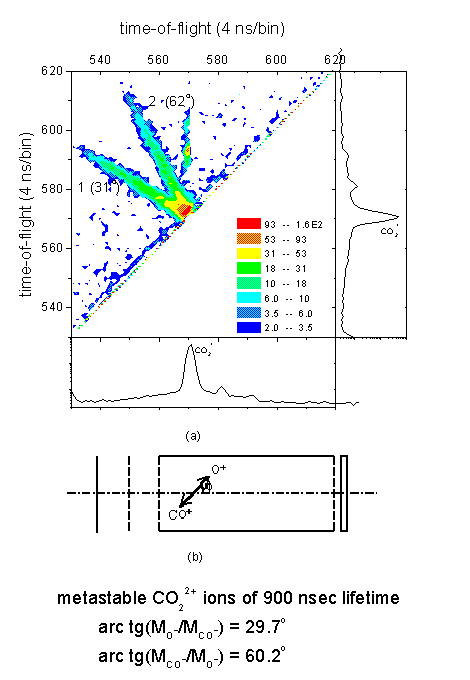|
Tab. 2.2: Zusammenstellung aller theoretischen und experimentellen metastabilen a3P (v, W , J) Lebensdauern. p bezeichnet die Parität des jeweiligen Rotationsniveaus. Alle Werte sind in Millisekunden angegeben. Tab. 2.2: Summary of all theoretical and experimental metastable a3P (v, W , J) lifetimes. p denotes the rotational level's parity. All values are given in milliseconds |
|
|
Kovariante Abbildung elektronenstoßangeregter Molekülionen |
Covariant mapping of molecular ions due to electron collisions |
|
Die im Vorjahr präsentierte Messung der Stoßquerschnitte von im Elektronenstoß erzeugten Molekülionen wurde durch eine Technik der kovarianten Abbildung ergänzt. Hierzu wurde eine spezielle Computersoftware des Vielkanalskalers von FAST eingesetzt, in der die Ankunftszeiten tA und tB von zwei Ionen A+ und B+ gemessen werden und aus ihnen nach der Methode der kovarianten Abbildung ein zweidimemsionales Bild der Bruchstücke der Molekülionen erzeugt wird. Dabei werden die Flugzeiten der verschiedenen Ionenbruchstücke und ihre Autokorrelation gegeneinander aufgetragen. In dieser Darstellung bilden sich dann sogenannte Inseln, wobei die Zahl der Ereignisse, die eine Insel bilden, ein Maß für den jeweiligen Querschnitt ist. Da die Flugzeit auch von den Geschwindigkeiten der beteiligten Ionen abhängt, ist jede Insel kein einfacher Punkt mehr. Aus der Form der Insel kann daher auf die Dynamik des Elektronenstoßes geschlossen werden. |
The previously presented cross-section measurements due to electron impact have been extended by the technique of covariant mapping. For this method a specially- designed computer software for the multi-channel scaler of FAST was used. In this method the two transittimes tA and tB of the two ions A+ and B+ are measured. With the method of covariant mapping a two dimensional picture of the molecular fragments is generated in which essentially the times of flight of the different fragments and their autocorrelation are plotted. In this representation various islands are formed. The number of island-forming events is a measure of the corresponding cross section. Since the time of flight depends also on the velocity of the ions, the islands do not form a sharp individual point. Instead the dynamics of the electron collision can be extracted. |
|
Abb. 2.45 zeigt die kovariante Abbildung des CO2 Moleküls bei Elektronenenergien von 600 eV, wobei die dabei auftretenden falschen Koinzidenzen bereits entfernt wurden. In Abb. 2.46 ist die Insel um das CO22+-Ion im Ausschnitt gezeigt.. Die Winkel der beiden Keulen 1 and 2 kann aus der Dissoziation der metastabilen Mo-lekülionen in die CO+ und O+ Fragmente bestimmt werden wie in Abb. 2.46 angedeutet. |
Fig. 2.45 shows the covariant mapping of the CO2 molecule at electron energies of 600 eV where the false coincidences have already been removed. Fig. 2.46 shows the specific island around the CO22+-ion. The angles of the two structures 1 and 2 can be determined from the dissociation of the metastable fragments CO+ and O+ as indicated in Fig. 2.46. |
|
|
|
|
Abb. 2.45: Kovariante Abbildung des Massenspektrums von CO2 bei einer Elektronenenergie von 600 eV nach Abzug der falschen Koinzidenzen. Fig. 2.45:Covariance mapping mass spectrum of CO2 at the electron energy of 600 eV after subtraction of the false coincidences. |
Abb. 2.46: Die Struktur der kovarianten Abbildung in der Umgebung der CO22+-Insel, deren metastabiler Abfall für die Struktur und deren Winkel verantwortlich ist. Fig. 2.46: The structure of the kovariant mapping in the vicinity of the CO22+-island whose metastable decay causes the structure and its corresponding angles. |

